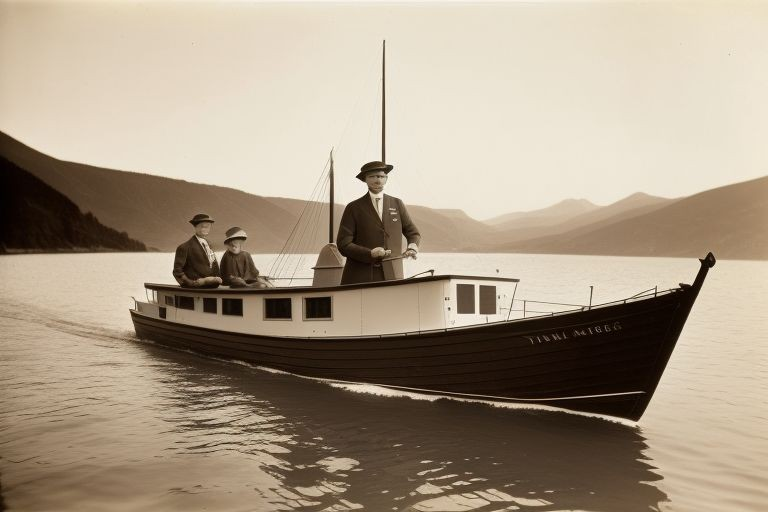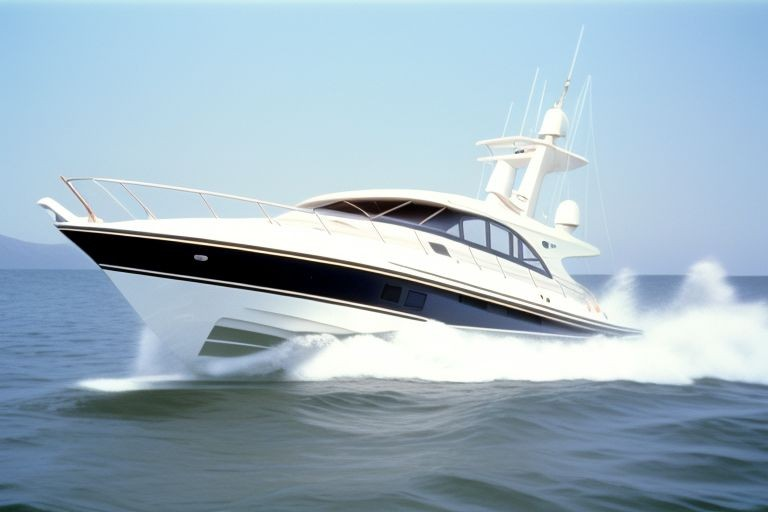The Quest for Mega Speed in Mega Yachts Part 2
Technology from the Early 1900's
Lightweight mono hulls, catamarans, surface effect vessels, surface piercing vessels, hydra foils. These are "state-of-the-art" 1988 high speed mega craft. Where do we go from here? Well, I propose that we do it ... that we really do it. Let's quit fooling around with innovations such as round windows instead of rectangular windows or nonfunctional tail fins. Let's bypass the next logical steps and make a great leap forward. Strangely enough, what I will propose now -- with tongue only lightly planted in cheek -- comes from technology that's been available since the early 1900's.
Picture this. A sleek, finned 120'er, rests at anchor in a sun drenched blue Mediterranean lagoon. The scene looks like an old Bridgette Bardot movie. The owner's party is lounging on deck, playing cards and taking in the sun. Others are snorkeling around the vessel. Music wafts from the on deck loud speakers and the tinkle of ice on crystal carries about the lagoon. It's late Sunday afternoon and the shadows are growing long. The owner glances at his watch. 3:30 p.m.. He needs to be in New York (which is six hours ahead) at 5:30 p.m. Sunday evening for an important meeting.
He gives the captain the "high sign" and the crew immediately starts scurrying about stowing gear and getting the guests aboard. The shrill whine of hydraulic motors is heard and, unbelievably, the sleek hull proceeds to deploy wings like a butterfly just out of the cocoon! The high pitched hydraulic whine continues until the wings lock in their service position. More hydraulic sounds are heard and massive flaps emerge from the leading and trailing edges of the wings. Then a whine much higher and more powerful than the first is heard as the port then the middle and finally the starboard jet engines are lit off. The sleepy little Mediterranean lagoon now sounds like the main runway at JFK!
The anchor is retrieved and the owner's party waves good-bye to the other yachts anchored in the lagoon as they taxi to open water. The shriek of the jets increase and the hull lifts off at 100 knots in a glorious blast of spray, kero fumes and heat waves. Once up, they do a tight 180 and buzz their companions below before setting course for New York City, three thousand miles and six hours away.
Or, how about this? One of the yachts left behind in the lagoon is a sleek 115' vessel with an extremely low profile. The teardrop shaped hull glistens in the late afternoon sun but the day is drawing to a close and it's time to leave. The crew makes ready for sea, the anchor is stowed and the vessel slowly and silently makes her way out into open water. It's extremely rough outside with the wind blowing 35 knots and seas six to nine feet. The captain is unconcerned. Once out, he gives the command to open the vents and flood all tanks. The sleek vessel disappears below the surface of the sea and heads home at her underwater cruising speed of a very efficient 60 knots. The owner's party adjourns to the extreme bow where the "Nemo Cabin" with clear lexan hull panels all around is located. Hull resistance is lessened by artificial porpoise skin applied to the shell and introduction of a lubricant in the bow area to lessen skin friction. The atomic reactor, which is the size of your average garbage pail, produces silent, effortless power to the high-speed turbines.
Well, there you go laughing again. They laughed at Leonardo's helicopter too. In fact, Pan Am had what amounted to flying yachts (their famous Clipper Flying Boats) 53 years ago and submarines have been around since the Civil War! The two scenarios presented above may be entirely possible for the well-heeled private individual.
An impossible dream you say. Well, despite American Industry bashing which is so popular nowadays, I have great faith in the capabilities of the American Industrial Machine when it comes to responding to new challenges or developing new technology. Most of the "GEE" technology that wows us these days in such fields as plastics, computers and communications originated in the USA as spinoffs from massive government funded NASA-type programs such as the moon landing, the space shuttle and the Jupiter flybys.
While these milestones themselves are astounding, the means of achieving these achievements is less than astounding. Given government backing, anything can be accomplished simply by throwing massive doses of taxpayer’s money at it. It's private industry that really impresses me, companies that go out and spend their own little money to develop new products. Companies that have the foresight and guts to put their profits into bold new ideas. What impresses the hell out of me are the less prominent but no less spectacular accomplishments of private industry.
Next month, we shall explore, in detail, an example of American ingenuity in the private manufacturing sector and explore the reasons why flying boats and subyachts could become the wave of the future. One may say that flying boats and submarines will be too expensive to be privately owned. To this, I can only reply that the modern mega yacht of 1988 is nearly as complicated as a big, modern plane or sub. Secondly, all it takes is bushels of dollars (which seems to be no problem nowadays and a uranium permit - should the sub route be taken). Hell, there must be a dozen guys that I personally know who have the modern equivalent of more money than Pan Am had in 1935. Some of these guys have more money than Pan Am has now!
(Reprinted with permission of Regina Fexas.)
If you would like to read more of Tom's pearls of wisdom, tune in next Friday -- "Fexas Friday."
Better yet, why not get a full dose of infectious Fexas whenever you need it -- and buy one of the volumes below. Better yet, why not buy all of them -- we call them the "Fexas Five." They will provide many evenings of fun reading (better than Netflix), and you'll make the widow Regina very happy knowing that Tom will live on with you the way most of us remember him.
Order 1, 2 or "The Fexas Five" --
To find the "Fexas Five" on Amazon, click here...
Tom Fexas (1941-2006) was one of the most influential yacht designers of the last quarter of the 20th century. With the narrow Wall Street commuters that were built in the 1920s and '30s always on the back of his mind, he wanted to design boats that were at once fast, comfortable, seaworthy and economical to operate. Over the years, he and his firm designed over 1,000 yachts for some of the most prestigious boat builders in the world, including Choey Lee, Palmer Johnson, Grand Banks, Mikelson Yachts, Burger, Abeking & Rasmussen and many others.
Even though toward the end of his career he only designed megayachts and superyachts, including the remarkably influential PJ "Time" in 1987, he is best remembered for his first major vessel in 1978 -- Midnight Lace -- which became a series of 44-52-footers. They were light, narrow, and fast with relatively small engines. He was also influential in the boating community because of the monthly column he wrote for Power and Motoryacht, which began in its very first issue in January 1985.


